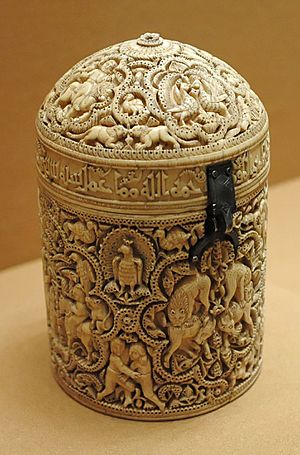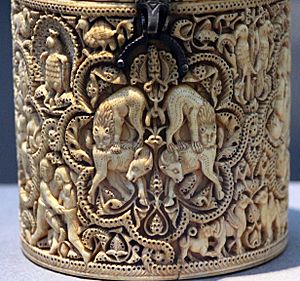Pyxis of al-Mughira facts for kids
The Pyxis of al-Mughira is a small, round box made from carved ivory. It was created in the year 968 CE (which is 357 AH in the Islamic calendar). This beautiful container comes from the time of Medieval Islam, specifically the Spanish Umayyad period. Today, you can see it at the Louvre museum in Paris, France.
This pyxis was likely made in a workshop in Medina Azahara, a city near modern-day Cordoba, Spain. Many historians believe it was a special gift for Prince al-Mughira when he became a young man. He was the son of Caliph 'Abd al-Rahman III, a powerful ruler. We know the pyxis belonged to al-Mughira because of a message carved around its lid. This message wishes him "Blessing from God, goodwill, happiness and prosperity."
Contents
What is a Pyxis?
A Special Container
A pyxis is a small, round box, often used to hold valuable items. In the past, royal families used these luxury containers for things like precious gems, jewelry, perfumes, or special scents. We don't know exactly what was kept inside al-Mughira's pyxis. There are no traces of any substances left inside it today.
The outside of the pyxis is covered with very detailed carvings. It is made from elephant ivory, which was brought from North Africa. Some people think the pyxis might have once had gold and silver decorations, but only tiny bits of jade remain.
The Lid and Its Mystery
The pyxis has a lid that was found with metal hinges. However, these hinges seem to have been added later, not when the pyxis was first made. This is because the hinges actually cut into the carved message on the lid. Because of this, it's a bit of a mystery how the lid was originally meant to sit on the box. This also makes it hard to know which side is the "front" or "back" of the pyxis.
The Four Carved Scenes
The most interesting parts of the pyxis are the four main carved circles, called medallions, around its middle. Each medallion tells a story or shows a symbol.
Medallion One: Falcons and Power
The first medallion shows two men trying to collect eggs from falcon nests. Falcons were a very important symbol for the Umayyad rulers. They represented power and the right to rule. For example, Abd al-Rahman I, who started the Umayyad rule in Spain, was even called "the falcon of the Quraysh."
In this scene, dogs are biting both men. Some experts think this might be a warning. It could mean that anyone who tries to take power from the Umayyads will face trouble.
Medallion Two: Date Palms and History
The second medallion shows two people on horseback picking dates from a date-palm tree. Date palms are common in the Middle East and North Africa. This scene might remind people of the eastern lands that the Umayyads lost to the Abbasid Caliphate. The Abbasids were another powerful family who took over from the Umayyads in many areas.
Abd al-Rahman I used the date palm as a secret symbol in his poems. Some scholars believe the tree's intertwining branches represent the two parts of the Umayyad family.
Medallion Three: A Royal Scene
Medallion three shows a scene from a royal court with music. There are two seated figures and a smaller figure in the middle, who might be a servant. One of the seated figures holds a special staff and a flask, which were symbols of the Umayyad rulers. The other figure holds a fan.
The meaning of this scene is debated. One popular idea is that the man with the staff and flask represents the Umayyad Caliph. The figure with the fan might represent the Abbasids. Some experts think this scene shows an important ceremony. It could have been a reminder to Prince al-Mughira about the strength and long life of his family's rule.
Medallion Four: Lion and Bull Fight
The fourth medallion shows a powerful scene: a lion fighting a bull. This is a common symbol of strength and authority. Many experts, including those at the Louvre, see this as a message about the Umayyad Caliphs' right to rule. It shows their power against their rivals, the Abbasid Caliphs.
Some scholars connect this scene to old fables, or stories with morals. These fables were often used to teach young people, especially those in royal families, important life lessons. This scene might have been a way to teach al-Mughira about loyalty. It could have warned him about the dangers of listening to bad advice or trying to go against his family's rule.
See also
 In Spanish: Píxide de Al-Mughira para niños
In Spanish: Píxide de Al-Mughira para niños



